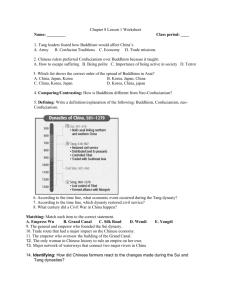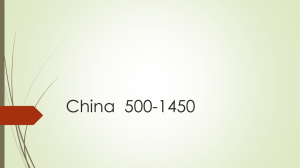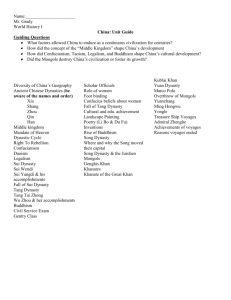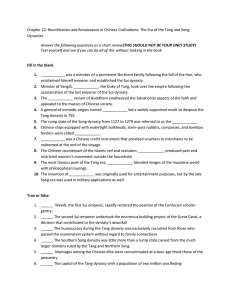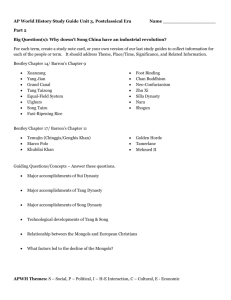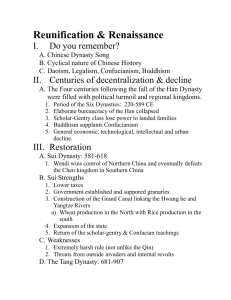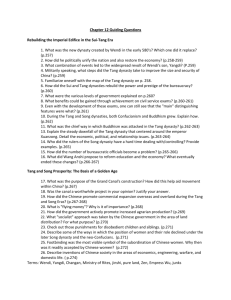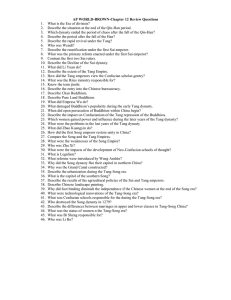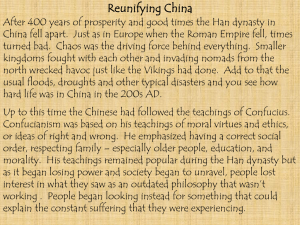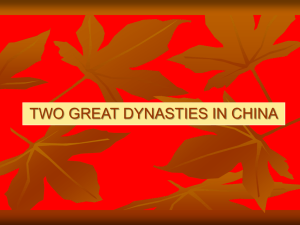Chapter 14 Notes
advertisement
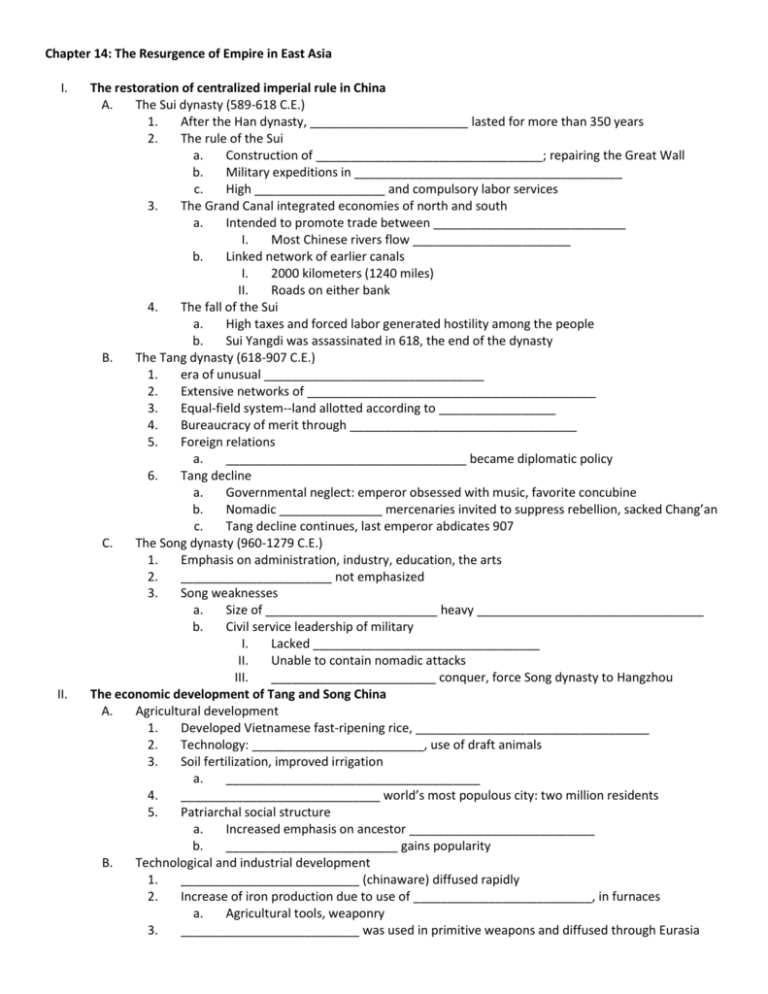
Chapter 14: The Resurgence of Empire in East Asia I. II. The restoration of centralized imperial rule in China A. The Sui dynasty (589-618 C.E.) 1. After the Han dynasty, _______________________ lasted for more than 350 years 2. The rule of the Sui a. Construction of _________________________________; repairing the Great Wall b. Military expeditions in _______________________________________ c. High ___________________ and compulsory labor services 3. The Grand Canal integrated economies of north and south a. Intended to promote trade between ____________________________ I. Most Chinese rivers flow _______________________ b. Linked network of earlier canals I. 2000 kilometers (1240 miles) II. Roads on either bank 4. The fall of the Sui a. High taxes and forced labor generated hostility among the people b. Sui Yangdi was assassinated in 618, the end of the dynasty B. The Tang dynasty (618-907 C.E.) 1. era of unusual ________________________________ 2. Extensive networks of __________________________________________ 3. Equal-field system--land allotted according to _________________ 4. Bureaucracy of merit through _________________________________ 5. Foreign relations a. ___________________________________ became diplomatic policy 6. Tang decline a. Governmental neglect: emperor obsessed with music, favorite concubine b. Nomadic _______________ mercenaries invited to suppress rebellion, sacked Chang’an c. Tang decline continues, last emperor abdicates 907 C. The Song dynasty (960-1279 C.E.) 1. Emphasis on administration, industry, education, the arts 2. ______________________ not emphasized 3. Song weaknesses a. Size of _________________________ heavy _________________________________ b. Civil service leadership of military I. Lacked _________________________________ II. Unable to contain nomadic attacks III. ________________________ conquer, force Song dynasty to Hangzhou The economic development of Tang and Song China A. Agricultural development 1. Developed Vietnamese fast-ripening rice, __________________________________ 2. Technology: _________________________, use of draft animals 3. Soil fertilization, improved irrigation a. _____________________________________ 4. _____________________________ world’s most populous city: two million residents 5. Patriarchal social structure a. Increased emphasis on ancestor ___________________________ b. _________________________ gains popularity B. Technological and industrial development 1. __________________________ (chinaware) diffused rapidly 2. Increase of iron production due to use of __________________________, in furnaces a. Agricultural tools, weaponry 3. __________________________ was used in primitive weapons and diffused through Eurasia III. IV. 4. Printing developed from _________________________________________ 5. Naval technology: "south-pointing needle"--the _____________________________________ C. The emergence of a market economy 1. Letters of credit developed to deal with copper coin shortages a. Flying cash (______________________________) 2. Development of independently produced ____________________ money a. Not as stable, riots when not honored 3. Government claims ________________________ on money production in eleventh century Cultural change in Tang and Song China A. Establishment of Buddhism 1. Increasing popularity of _________________________ 2. Christianity, Manichaeism, Zoroastrianism, Islam also appear 3. Buddhism in China a. Attraction: moral standards, intellectual sophistication, and _____________________ b. Monasteries became _______________________________, helped the poor and needy c. Also posed a challenge to Chinese ________________________ 4. Wu Zhao a. Buddhist powers were broken and replaced by __________________________ b. Reason: Buddhism was seen as undermining the family system (no tax, no army) and eroding the tax base by ______________________________ and attracting too many to be monks and nuns. Buddhism legitimized ____________________________________. c. Wu Zhao: took control of the _________________________ and made HERSELF emperor with the support of _________________________ d. Crackdown of _________________________-scholars could paint Wu in a bad light so women could not get many rights B. Neo-Confucianism 1. Keep Confucianism philosophies 2. “Neo” (new) philosophy: get rid of _______________________________________because they are detrimental to Chinese society Chinese influence in east Asia A. Early Japan 1. Adoption of _________________________________ teachings 2. Yet retention of _____________________ religion B. Medieval Japan was a period of decentralization 1. Institution of the Shogun a. Minamoto leader named shogun, 1185 C.E. b. Ruled from Kamakura, allowed imperial throne to continue in ________________ c. Shogun: _______________________________________________ 2. The samurai a. Professional warriors of ___________________________ b. Valued _______________________________________________________________ c. Observed samurai code called ____________________ d. To preserve their honor, engaged in ritual suicide called ____________________
